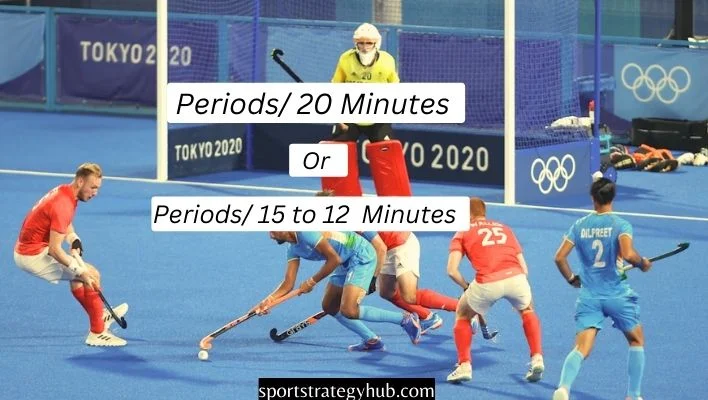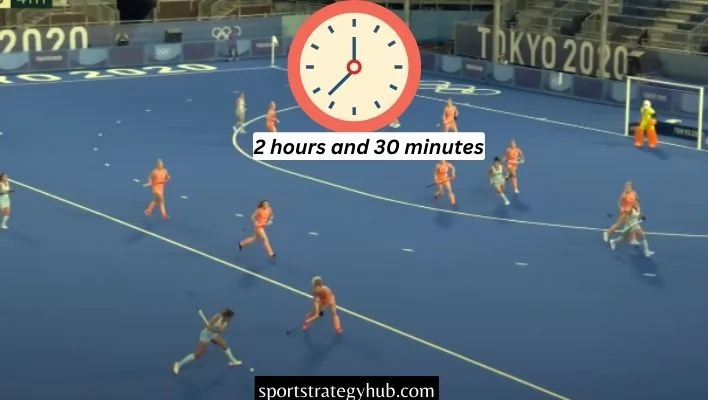How Long Is a Hockey Game: NHL | International | Amateur
Hockey enthusiasts, both seasoned fans and curious newcomers, frequently inquire about the game’s duration. Knowing the precise length of a hockey match allows fans to organize their schedules effectively and immerse themselves fully in the sport. In this comprehensive guide, we will explore the structure of a hockey game, the average duration in different leagues, and the factors that can affect game length. Whether you’re a die-hard fan or new to the sport, this article will provide you with all the information you need to know about the duration of a hockey game.
What are Hockey Game Basics
Hockey is a fast-paced and exciting sport played on ice. Two teams, each consisting of six players, compete to score goals by shooting a puck into the opponent’s net. The game is divided into three periods, with each period traditionally lasting 20 minutes of actual gameplay. In between the periods, some intermissions allow players to rest and strategize. These intermissions also provide opportunities for in-arena entertainment and commercial advertising. Understanding the fundamental layout of a hockey match is crucial for understanding how its duration is decided and what factors can impact it.
Periods and Intermissions
Hockey matches consist of three periods, each with 20 minutes of actual gameplay. These periods are interspersed with scheduled breaks called intermissions. Teams utilize intermissions for rest, strategy planning, and adjustments. Moreover, intermissions facilitate in-arena entertainment and commercial ads. Typically lasting around 17 minutes, intermissions offer sufficient time for teams to regroup and for TV networks to air commercials. This division of the game into periods and the inclusion of intermissions play a crucial role in structuring the game and can influence its total duration.
The Structure of the Game
Most hockey leagues, such as the NHL, organize games into three periods, with each period lasting 20 minutes of active gameplay. However, it’s important to note that the structure of the game can vary based on the league or level of play. International competitions like the IIHF World Championships and the Winter Olympics also follow the pattern of three periods, each lasting 20 minutes.

On the other hand, youth and amateur hockey leagues may have shorter periods, typically ranging from 15 to 12 minutes, to accommodate the players’ age and skill level. Understanding the variations in game structure is crucial in determining the duration of a hockey game.
How Long Is The Average Hockey Game?
The length of a hockey game can vary depending on multiple factors. Professional games in leagues such as the NHL generally span about 2 hours and 30 minutes on average. This includes the three 20-minute periods of gameplay, as well as intermissions and other stoppages. International competitions and youth hockey games may have slightly different durations, depending on the specific rules and regulations of the league. Additionally, factors like commercial breaks, penalties, and possible overtime periods can impact the overall length of a game. Understanding the average duration of a hockey game in different contexts is essential for fans and players alike.
See Also: How Long are Baseball games
Professional Leagues (NHL)
In the National Hockey League (NHL), which is the top professional hockey league in North America, games typically last about 2 hours and 30 minutes. This time frame comprises three 20-minute periods of active gameplay, separated by intermissions lasting around 17 minutes each. However, it’s crucial to recognize that the precise duration of a game can fluctuate due to factors like penalties, goals, and stoppages in play. The game’s high speed and the possibility of overtime periods can also influence the overall length of an NHL hockey match.
International Play
In international hockey competitions, such as the IIHF World Championships and the Winter Olympics, the game duration is generally consistent with the format used in North American professional leagues. Hockey matches usually consist of three 20-minute periods, separated by intermissions. However, there may be variations in the rules governing overtime and shootout formats, which can affect the overall game duration in the case of a tied score at the end of regulation time. These differences introduce excitement and unpredictability into international hockey matches.
Amateur and Youth Hockey
Amateur and youth hockey leagues often have variations in game duration compared to professional leagues. The length of periods can be shorter, typically ranging from 15 to 12 minutes, to accommodate the players’ age and skill level. These shorter periods lead to shorter game durations overall. The purpose of adjusting the game structure in amateur and youth hockey is to ensure that players have an appropriate amount of playing time and to create a developmentally appropriate environment for their growth in the sport.
How Long Is A High School Hockey Game?
High school hockey games generally follow the standard structure of three 17-minute periods, making the total duration of a game approximately 51 minutes. Yet, it’s crucial to highlight that the length of a game can fluctuate due to factors like stoppages in play, penalties, and potential overtime periods. Additionally, some high school leagues may have specific rules that influence game time, such as running clocks in certain situations. Overall, high school hockey games offer an exciting and fast-paced experience within a shorter time frame compared to professional leagues.
High School Hockey Overtime
In high school hockey, overtime periods are handled differently depending on the league or state association rules. Certain leagues may adopt a sudden-death overtime format, where the team scoring first during the extra period secures victory, while others may use a shootout to determine the winner. Overtime periods in high school hockey typically last for five minutes of continuous play. If the game remains tied after the first overtime period, additional periods or a shootout may follow until a winner is decided. These overtime scenarios can extend the total length of the game.
Duration of Women’s Hockey

Women’s hockey games generally follow the same structure as men’s games, consisting of three periods of equal duration. The periods typically last 20 minutes each, with intermissions in between. The game duration in women’s hockey is comparable to men’s hockey, with games lasting around 2 hours and 30 minutes, including intermissions and stoppages.
However, it’s important to note that there may be variations in game structure and rules based on the specific league or level of play. Overall, women’s hockey offers the same thrilling action and competitiveness as men’s hockey within a similar timeframe.
Factors Affecting Game Duration
Several factors can affect the duration of a hockey game beyond the basic structure of periods and intermissions. The duration of televised games can be extended due to commercial breaks. Whistle stoppages for penalties, offsides, and puck out-of-play also contribute to game length. Overtime periods and shootouts, which occur in case of a tie, can significantly extend the total time of a game. Knowing about these factors assists fans in predicting the duration of a hockey game and making plans accordingly.
Commercial Breaks
Television broadcasts of professional hockey games include scheduled commercial breaks. These breaks provide valuable advertising opportunities for TV networks and sponsors. The frequency and length of these commercial interruptions can differ based on the broadcasting network and contractual arrangements. Although these breaks extend the game’s overall duration, they are essential for the financial backing of the league and the broadcasting networks. Commercial breaks also allow players to rest and strategize during intermissions, adding to the strategic nature of the game.
Whistle Stoppages

Hockey is a highly regulated sport, and referees stop play for various reasons, including penalties, icing, offsides, and when the puck goes out of play. These interruptions in gameplay can considerably extend the duration of a hockey match. Penalties, in particular, require players to serve time in the penalty box, and the game clock continues to run during most penalty times. The rate of interruptions can fluctuate based on the playing style and the level of competitiveness in the game.
Overtime and Shootouts
If a game ends with a tied score after regulation time, extra periods may be played to determine the victor. The format for overtime differs based on the league and level of competition. In leagues such as the NHL, sudden-death overtime is employed, reducing teams to four skaters each. Should no winner emerge during overtime, a shootout might occur to determine the game’s outcome. Overtime and shootout situations can notably prolong the overall length of a hockey match, particularly in critical playoff games.
Other Posts
How is Softball different than Baseball
FAQs
Hockey game warm-ups typically last around 15 to 20 minutes, allowing players to prepare mentally and physically for the game ahead.
In hockey, there are six players on the ice at the same time for each team, consisting of one goaltender and five skaters.
A penalty in hockey occurs when a player violates the game’s rules. Penalty durations can differ based on severity, ranging from two minutes to a major penalty.
In a “stop-time” game, play stops the game clock whenever there are penalties, goals, or other breaks, allowing for a more precise calculation of actual gameplay time.
When a penalty occurs in a hockey game, the game clock continues to run, extending the duration of the period due to the stoppage in play.
In regular NHL season games, if a match ends in a tie after regulation time, it advances to a sudden-death overtime period. If no winner is decided during overtime, a shootout occurs to determine the result.
During an NHL game, the intermission between periods generally spans approximately 17 minutes, providing teams with time to rest and strategize, and allowing TV networks to air commercials.
Conclusion
In summary, the duration of a hockey match can vary depending on factors like the league and level of competition. Additionally, unforeseen events during the game can also influence its length. Understanding the structure of the game, the impact of intermissions, and the factors that can extend game time is essential for fans and players alike. Whether you’re a die-hard fan planning your schedule or a newcomer curious about the sport, knowing how long a hockey game lasts will enhance your enjoyment. So, go ahead and dive into the exciting world of hockey, knowing the length of the game, and be ready to cheer for your favorite team.
